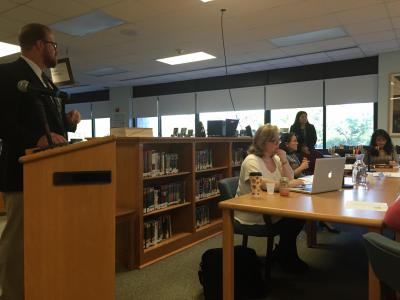Changes Not in Approved Plan Raise Board’s Hackles

Certain items included as part of a construction project at Pierson Middle and High School, which was approved by public referendum in 2013, were said on Tuesday, during a meeting of the Sag Harbor School Board, not to be in the cards after all, including a loss of five parking places at Pierson where plans called for a gain of that many. Board members questioned whether the scope of the work has changed without the knowledge of the board or the public.
The New York State Education Department took about a year and a half to approve the plans, during which time inflation raised the initial cost estimates substantially. That in turn meant that certain components had to be characterized as “add-ons” — able to be built only if money was left over after the main work was completed.
The problem is there won’t be any money left for them, said Katy Graves, the superintendent.
But Chris Tice, the Sag Harbor School Board vice president, insisted that some of the items had been presented to the public as definitely included. Besides the five parking spots, a lighting and sound booth was to have been installed on the balcony level of the Pierson auditorium, which is undergoing a complete overhaul. Larry Salvesen of BBS Architects and Engineers, the district’s architectural firm, told the board on Tuesday that the booths would instead be separated and installed on two levels.
“We should have been a little more aware. Part of the problem was that it happened so long ago and there was so much time in between,” Susan Kinsella, the school board president, said by phone yesterday. “When it was being proposed to us, they said we could gain some parking spaces in the front. It was a big deal. That was a concern to me because the board actually had to vote on that.”
If a piece of the overall project was submitted to the state for approval, Ms. Tice said, “We assumed it was going to happen . . . nothing was labeled ‘alternate’ ” or add-on, she said. “It was not discussed that way at the board meetings.”
“After we had all the public discussions and the board discussions . . . there was a design phase that I don’t think was fully vetted with the board,” Theresa Samot, a board member, said during the meeting.
Mr. Salveson responded that large-scale projects are not normally fully designed before being submitted to voters for approval; rather, the final details are worked out later.
“I’m sure two years ago I did come and talk to you about this,” he said. “As we went through design and development, it was fully available to everyone for general knowledge, because we knew how sensitive it was.”
The discussion seemed to peak when Mr. Salveson unveiled the full design for the auditorium, with a maritime theme and color palette honoring Sag Harbor’s history as a port town. While the board agreed the design was beautiful, some asked that the school colors of red and black be incorporated. Mr. Salvesen replied that the fabric for seat covers and other design components would have to be ordered very soon, and warned that any time spent on redesign could delay the auditorium part of the project.
With regard to some of the add-ons that the boards considers too important to safety to be eliminated, such as fixing a railing outside the elementary school and adding a sidewalk along the Atlantic Avenue parking lot, Ms. Graves said “there are resources to do what’s best for children.” Money may also be available to add lighting to the bus parking lot on Grand Avenue, which was requested by the bus drivers but which is also now on the add-ons list.
The discussion began with a public hearing earlier in the meeting, during which school administrators proposed using $645,000 from the district’s repair reserve fund to supplement the construction work. Following the hearing, the school board voted to award a $1.091 million contract for site repairs to Laser Industries Inc. That sum includes the $645,000 from the repair reserve, which will leave less than $3,000 in the reserve fund. Officials anticipate replenishing it with $500,000 from a projected surplus in the operating budget at the end of the current school year.
Also at the meeting, board members resolved to ask the New York State Legislature to enact a local law allowing the public to vote on a change of use for money raised in a November 2013 bond referendum for the synthetic turf field. While the field had support at that time, and continues to have support among some in the community, a large group of parents has petitioned the district to abandon the turf idea and opt for a natural grass field instead.
